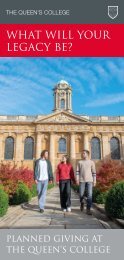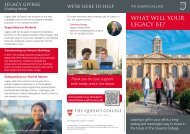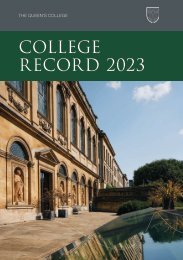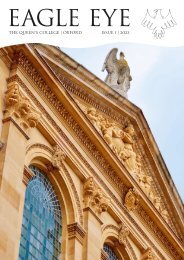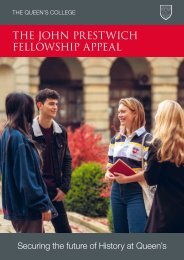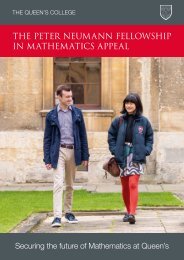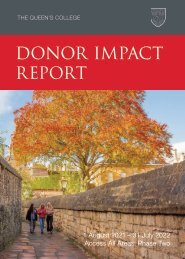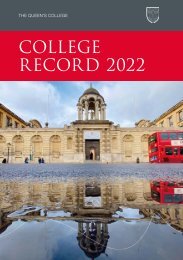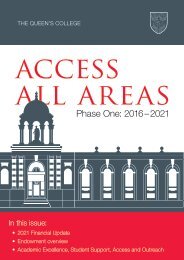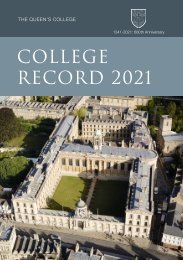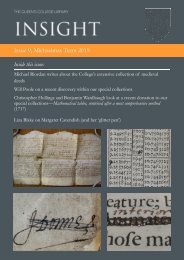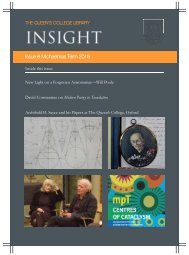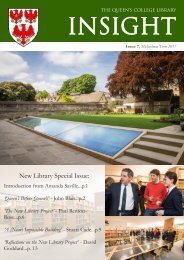The Queen's College Record 2020
Create successful ePaper yourself
Turn your PDF publications into a flip-book with our unique Google optimized e-Paper software.
Bridging the gap between science and the arts:<br />
Clifford Norton Fellows and Students at Queen’s<br />
Dr Christopher D. Hollings, Clifford Norton Senior<br />
Research Fellow<br />
Over the last half century, Queen’s has hosted more<br />
than a dozen researchers working on topics in the<br />
History of Science, with the History of Medicine and the<br />
History of Mathematics being the two major themes. This<br />
association between the <strong>College</strong> and the History of Science grew, at least in part, from a<br />
bequest made to the <strong>College</strong> in 1964 by an Old Member, the diplomat Sir Clifford Norton<br />
(1891-1990), who sought to forge a new link between the sciences and the humanities.<br />
Articles<br />
Clifford John Norton was born in Greenwich in 1891. He studied at Rugby School,<br />
before entering Queen’s as a Foundation Scholar in 1910. His tutor was the classicist,<br />
and future Provost of the <strong>College</strong>, E. M. Walker; Norton took a First in Classics<br />
Moderations in 1912 and then a Third in Literae Humaniores in 1914. He served at<br />
Gallipoli and in Palestine with the Suffolk Regiment during the First World War, and<br />
eventually entered the Foreign Office in 1921; throughout much of the 1930s, he<br />
served as private secretary to the permanent under-secretary Sir Robert Vansittart,<br />
before being posted to Warsaw in 1937. After a further foreign posting to Bern, he<br />
was appointed British Ambassador to Athens in 1946, a position that he held until his<br />
retirement in 1951. Upon returning to the UK,<br />
he sought to re-establish his connection with<br />
Queen’s, and was for a time President of the<br />
Queen’s Association; in 1963, he was elected<br />
an Honorary Fellow of the <strong>College</strong>. Norton<br />
died in London in 1990, seven months short<br />
of his one-hundredth birthday.<br />
As early as 1952, Norton had written to<br />
the Bursar to signal his intention of leaving<br />
a bequest of £2,000 to the <strong>College</strong>, and<br />
was already wondering whether to earmark<br />
it for a specific purpose. Discussions<br />
appear to have taken place between<br />
Norton and members of the <strong>College</strong>, and<br />
by 1960 he had accepted the suggestion<br />
that his bequest (now having risen to<br />
£10,000) be used to fund a ‘Clifford Norton<br />
Research Fellowship’. By 1964, Norton<br />
had decided to turn his proposed bequest<br />
into an immediate gift, and was musing<br />
on possible subjects for the Fellowship:<br />
Sir Clifford John Norton, by Walter<br />
Stoneman. Bromide print, 26 August<br />
1948, NPG x186891 (© National Portrait<br />
Gallery, London)<br />
<strong>College</strong> <strong>Record</strong> <strong>2020</strong> | <strong>The</strong> Queen’s <strong>College</strong> 105






